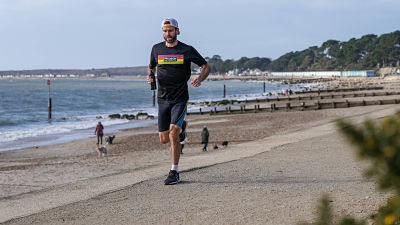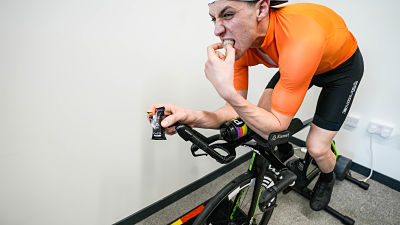If you hang around with endurance athletes for long enough, you’re likely to meet men who openly talk about shaving their legs and you’ll almost certainly hear some chat about ‘fasted training’, ‘training low’ or ‘fat burning sessions’.
What do these phrases actually mean? Whilst the exact techniques and strategies may differ slightly, they all essentially focus on deliberately limiting carbohydrate intake before or during workouts in the hope that this will increase positive training adaptations…
Why might you train fasted?
Deliberately depriving yourself of calories in the build-up to endurance exercise seems counterintuitive, especially to those of us who’ve been schooled on the importance of carb loading for peak performance. After all, fueling adequately is a proven strategy to maximise training or racing intensity and to enhance recovery.
But fasting for general metabolic health is something that has gained a lot of credibility in recent years and has been talked about by learned people in sports science as a way to increase athletic performance. As such, there are some plausible sounding theories that suggest training with low energy levels might offer benefits that aren’t available if we train in a well-fed state all of the time.
In fact, the theories underpinning fasted training appear to be built on some pretty robust scientific evidence.

Studies have shown that exercising with low energy availability (and, more specifically, low carbohydrate availability) can drive enhanced metabolic and cellular responses, which in turn could theoretically lead to better performance outcomes in the long run (even if performance in a single fasted session is impaired).
This is because the enhanced cellular adaptations promoted by fasting increase what’s known as ‘the endurance phenotype’ - a fancy way of saying that the adaptations from this kind of training make you ‘look like’ a better endurance athlete at a cellular level by enhancing the metabolic machinery your body needs to efficiently spare carbs and burn fat as fuel.
So, is it a good idea to skip a few meals and to do some of your workouts in a deliberately fasted or low-carb state?
The drawbacks of fasted training
The theoretical backdrop to fasted training developing positive cellular adaptations is grounded in solid science, but an equally well qualified 2021 meta-analysis of 407 scientific papers on the subject concluded, rather damningly, ‘that periodised carbohydrate restriction does not per se enhance performance in endurance-trained athletes’.
In other words, despite the very plausible sounding reasons why fasted training might improve performance, the evidence doesn’t point to it actually making you swim, bike or run any faster than if you did your training well-fueled.
This is an interesting and important conclusion because there are significant risks associated with training low on energy rather than on lots of carbs. Specifically, training in a depleted state can result in impaired recovery from sessions, suppress your mood, your immune system and, if not done in a very carefully controlled manner, it could contribute to the development of a problematic condition called RED-S.
If these significant risks aren’t hedged against a substantial potential upside, it starts to sound like it’s not such a good idea to practice fasted training…
Do top athletes train fasted?
To get some real world perspective from someone with a wealth of experience of working with endurance athletes at the highest level, I picked the brains of world-renowned ultra-running coach Jason Koop. Jason is an avid follower of the scientific literature on endurance performance and he didn’t mince his words when sharing his opinion on training in a fasted state:
The negatives of fasting outweigh any of the positives from a performance standpoint. Yes, you CAN try to get some of those promised cellular adaptations, but is it worth it? I think in nearly all cases the answer is ‘no’.
Koop also said that he thought that social media and the internet “make it feel like fasting and ketogenic (very low carb) diets are far more prevalent than they actually are among athletes. In reality, there are very few people that do this sort of thing.” In other words, Koop feels that most athletes aren’t actually practicing a lot of fasted or low-carb training and this is probably a good thing.

Indeed, a 2016 research paper by Dr Trent Stellingwerf looked at this perception vs reality in the ultra-running world and emphasised that the notion of fasted training being used regularly is more of an optical illusion than a reflection of common practice amongst high performing athletes.
Perhaps the perception that fasted training is a big deal has actually got more to do with the fact that it’s currently a trendy topic having its moment in the sun, rather than being a genuinely popular technique that actually benefits most athletes, most of the time?
Why carbs are king
So, what are athletes doing in the real world? Respected triathlon podcast host and coach Mikael Eriksson is a scientific thinker whose opinion carries weight and he had this to say about the concept of fasted training:
I have quite a bit of experience of using fasted or carb-restricted training in my athletes. My feeling is that these interventions didn’t give any of the athletes any added benefit beyond training with high-carb availability as much as possible.
Eriksson went on to say that he actually found fasted training to have been less helpful than consistently training in a well-fed state:
For many athletes, I see the opposite: an intense focus on high-carb availability in all workouts is what I've found can be a game-changer. Fasted training has in my experience led to stagnation or no added benefits.
I have to say that, for the most part, my own experiences of playing around with fasted workouts (primarily as a weight loss tactic rather than specifically to drive cellular adaptations) tend to align with the opinions of Koop and Eriksson.
Whenever I’ve tried doing a substantial amount of training in a low energy state, it never seems to have been particularly helpful to either body composition or fitness and has more often been a catalyst for illness and underperformance.
I think that this is perhaps because, like many endurance athletes, I’ve tended to be quite aggressive with the approach by radically underfueling long training sessions during periods of heavy training load, rather than doing it in a more controlled or subtle way. This led to flirtations with a prolonged low energy state during heavy training weeks, which is known to be detrimental to health and performance in the long run.

Although I no longer compete anywhere near as competitively as in my younger days, I’ve recently seen substantial benefits from going completely the other way and being way more aggressive with my carbohydrate intake before and during long, hard training sessions and races than I generally used to. This has actually been a revelation when it comes to my recovery after long runs or bike rides in particular.
I’ve found that if I really pay attention to loading up on carbs before and during my harder workouts, I have way more energy and motivation to keep up with the children during my role as a dad for the rest of the day, compared with times when I fuel more sparingly.
Should you train fasted?
Whilst I don’t think that doing a large proportion of your training in a deliberately low energy state is sensible for the majority of athletes in most situations, I also don’t think it’s correct to write the idea off entirely.
After all, the science has demonstrated that these measurable metabolic benefits from well controlled, fasted workouts are likely to be beneficial for overall health, even if they’re not directly performance-enhancing.
Registered dietitian and specialist in fueling for endurance sports, Dina Griffin, said that she felt there is potentially a role for some level of fasted training in the regimes of less experienced athletes, as a means to enhance the gains they were able to make from lighter training sessions in their programmes.
Perhaps in recreational (less trained) athletes, a few shorter fasted sessions early on in the base training phase is doable, so long as all of their other nutrition and health needs are met and monitored.
Dina was careful to emphasise that fasted training was a tool to use sparingly (if at all), under controlled conditions and for relatively short and light training sessions. She also pointed out that re-fueling adequately and quickly after fasted training was critical to ensure good recovery.
In summing up her thoughts, Dina said:
While some of the results of studies show that we can incorporate some manipulation to carbohydrate availability and there can be potential gains, it isn’t necessary. Will fasted interventions cause more stress upon the athlete? Perhaps. Is it ‘fun’ for the athlete? Not very often.
Ultimately, training fasted or with low-carbohydrate availability is something that feels like it’s a relatively hot topic in sport science at the moment. Even the most cursory search of the web will yield a host of people recommending it as a virtuous and performance-enhancing technique that you should add to your training regimen.
But dig a little deeper and many of the claims being made seem to be less rooted in hard evidence than the level of hype would suggest. And those ‘in the know’ seem to be in favour of training in a properly fueled state the vast majority of the time in order to get the most from your training and to maximise your performance and recovery.
